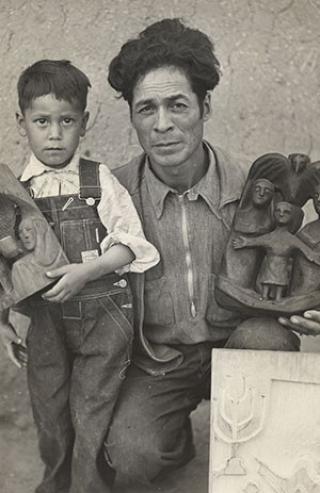Born 1900, Bisbee, Arizona
Died 1964, Taos County, New Mexico
An integral figure in twentieth-century Hispanic and New Mexican art history, Patrociño Barela rose to art world celebrity in the 1930s, an unlikely prospect for someone of his background. He had left home at age eleven following the death of his mother and sister to travel around the Southwest in search of work. He ended up as a laborer in Denver, Colorado, before getting married and settling in New Mexico in 1930. Asked to reconstruct a damaged wooden bulto (a devotional carving), Barela then began making his own wooden sculptures. His prodigious output soon caught the eye of Russell Vernon Hunter, artist and state director of the WPA, who signed Barela up for the Federal Art Project (FAP). By the summer of 1936 Barela’s sculptures were on display at the Museum of Fine Arts in Santa Fe, and in September of that year they appeared in New Horizons in American Art at MoMA. In the wake of the exhibition, Time magazine named Barela its “Discovery of the Year.”
Deeply carved out of pine, Barela’s Figure (Santo Niño) was one of eight objects by this artist exhibited at MoMA. In contrast to traditional bultos, made from multiple individually carved elements, his creations radically reinvented the genre, as they were directly carved from a single piece of wood. With its stylized rendering of the infant Christ kneeling in prayer, Santo Niño demonstrates the formal coincidence between Barela’s sculptural forms and the modernist investment in non-Western sculpture. His Saint George—carved from a piece of juniper—shows the saint rising victoriously over the head of the slain dragon.
The artist’s bultos are motivated by his own metaphysical relationship to Christianity. In showing religious subjects through an abstracted style, he intended for his works to provoke the viewer’s imagination into entering a spiritually symbolic vision. Central to his vision is a tension between the recalcitrance of wood and the animated dynamism of his subjects.
Nicholas Miller
Lew Thwaite, Stephanie. A Contested Art: Modernism and Mestizaje in New Mexico. Norman: University of Oklahoma Press, 2015.
Nunn, Tey Marianna. Sin Nombre: Hispana and Hispano Artists of the New Deal Era. Albuquerque: University of New Mexico Press, 2001.
